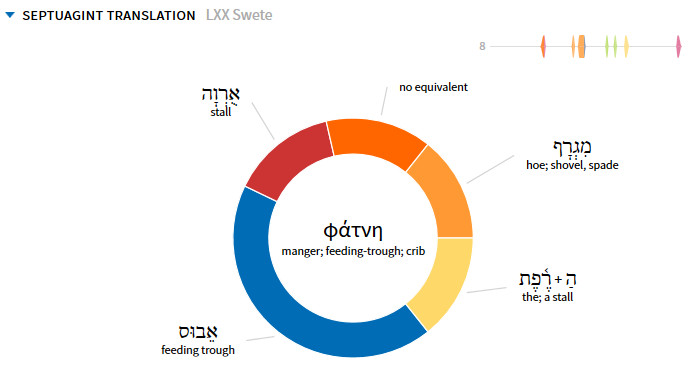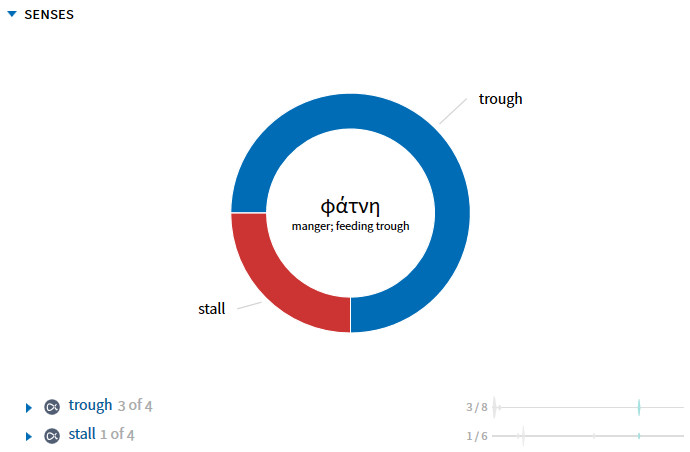Manger2016
- 2015-12-27
- By Editor
- Posted in Bible Study, Word Study
A word study of the Greek word translated “Manger” that is found four times in the Gospel of Luke. What would the manger look like back then? Read the following and you decide how accurate it has been translated in the 21st century.
Luke 2:12 (ESV)
12 And this will be a sign for you: you will find a baby wrapped in swaddling cloths and lying in a manger.”
Greek Word: “Phatne” Luke 2:12 a definition and the definition from various dictionaries & Lexicons
Strongs – G5336 φάτνη [phatne /fat·nay/] n f. From pateomai (to eat); TDNT 9:49; TDNTA 1251; GK 5764; Four occurrences; AV translates as “manger” three times, and “stall” once. 1 a crib, a manger.[1]
Louw-Nida – 6.136 τρύβλιον, ου n: a relatively deep bowl or dish—‘bowl, dish.’ ὁ ἐμβάψας μετ’ ἐμοῦ τὴν χεῖρα ἐν τῷ τρυβλίῳ ‘he who dips his hand in the dish with me’ Mt 26:23. In the two NT occurrences (Mt 26:23; Mk 14:20) τρύβλιον can be understood as a part of an idiom (literally ‘to dip one’s hands into the bowl with someone’) meaning ‘to share a meal with someone.’ If, however, the idiom is to be translated literally (and this is normally the case), there are certain difficulties involved, since a literal rendering of ‘to dip one’s hand into a bowl’ might mean literally putting one’s fingers or hand into a bowl rather than dipping in food which one holds in the hand. An idiomatic interpretation of ‘sharing a meal with someone’ or ‘eating together with’ may be preferable. But if one does translate the idiom somewhat literally, it is important in some languages to render this phrase as ‘to dip food into a bowl together with someone’ or ‘to jointly dip food into sauce.’
The related word in the Louw-Nida
LN 6.137 φάτνηa, ης f: a box or crib where animals feed—feed box, manger, crib’ (or possibly even an open feeding place under the sky). ἀνέκλινεν αὐτὸν ἐν φάτνῃ ‘she placed him in a manger’ Lk 2:7.
φάτνηa occurs only in Lk 2:7, 12, 16, and it may be important in some languages to distinguish clearly between various alternatives. The term ‘crib’ normally refers to the place where an animal stands when it feeds. The ‘manger’ is a relatively large box or rack containing hay, and a ‘feed box’ is a much smaller container, usually for grain. There is, of course, no way of knowing precisely where the baby Jesus was placed, but it would be very appropriate for the baby to have been placed in the feed box or in the manger. See also 7.64.[2]
LN 6.135 παροψίς, ίδος f: a relatively flat dish, probably somewhat smaller than a πίναξ (6.134)—‘plate, dish.’ καθαρίζετε τὸ ἔξωθεν τοῦ ποτηρίου καὶ τῆς παροψίδος ‘you cleanse the outside of the cup and dish’ Mt 23:25. In this one NT context in which παροψίς occurs, it seems to refer to any kind of plate or dish, though in contexts outside the NT, παροψίς is often employed to refer to a dish used for serving certain choice foods and delicacies.
BDAG: φάτνη, ης, ἡ (also πάθνη, s. Schwyzer I 269; cp. PLips 106, 8 [I a.d.]) manger, crib (so Hom.+; loanw. in rabb.) Lk 13:15. In the Infancy Narrative Lk 2:7, 12, 16 (ἔβαλεν ἐν πάθνῃ βοῶν GJs 22:2; on Lk 2 as anticipation of Jesus’ entombment s. JWinandy, NTS 43, ’97, 140–46) φ. could perh. be a stable (Diod S 17, 95, 2 φ. is a place to keep horses, beside κατασκήνωσις, a place for humans to stay; Aelian, NA 16, 24 p. 402, 10 w. ὁδός) or even a feeding-place under the open sky, in contrast to κατάλυμα, a shelter where people stayed (s. HCadbury, JBL 45, 1926, 317–19; 52, ’33, 61f) or other type of accommodation (s. κατάλυμα.—Manger: AvanVeldhuizen, NThSt 13, 1930, 175–78). Nicol. Dam.: 90 Fgm. 3 p. 330, 15 Jac.—MDibelius, Jungfrauensohn u. Krippenkind ’32, 59ff (Botschaft u. Geschichte I ’53, 1–78).—BHHW II 1014. DELG. M-M. TW.[3]
Analytical lexicon of the Greek New Testament
φάτνη, ης, ἡ (1) as a feeding place stall, stable (LU 13.15); (2) as a feed trough manger, crib (LU 2.7)[4]
Dictionary of Biblical Languages with Semantic Domains
5764 φάτνη (phatnē), ης (ēs), ἡ (hē): n.fem.; ≡ Str 5336; TDNT 9.49—1. LN 6.137 feed box, hay manger (Lk 2:7, 12, 16+); 2. LN 7.64 feed stall (Lk 13:15+)[5]
Exegetical dictionary of the New Testament
φάτνη, ης, ἡ phatnē manger
Luke 2:7, 12, 16: ἐν (τῇ) φάτνῃ, “in the manger,” referring to Jesus, who was placed in a feeding manger after his birth. 13:15 refers to the ox or donkey one looses “from the manger” in order to lead it to water. M. Hengel, TDNT IX, 49–55.[6]
The LXX – Septuagint Translation uses the basic Greek in eight different ways – note listed below:
The Senses show two words: Trough: 3 of 4 times and Stall 1 of 4 times…
The ESV version Uses ‘manger’ for each of the four time – these text are:
Luke 2:7 (ESV)
7 And she gave birth to her firstborn son and wrapped him in swaddling cloths and laid him in a manger, because there was no place for them in the inn.
Luke 2:12 (ESV)
12 And this will be a sign for you: you will find a baby wrapped in swaddling cloths and lying in a manger.”
Luke 2:16 (ESV)
16 And they went with haste and found Mary and Joseph, and the baby lying in a manger.
Luke 13:15 (ESV)
15 Then the Lord answered him, “You hypocrites! Does not each of you on the Sabbath untie his ox or his donkey from the manger and lead it away to water it?
Compare with the New King James Version:
Luke 2:7 (NKJV)
7 And she brought forth her firstborn Son, and wrapped Him in swaddling cloths, and laid Him in a manger, because there was no room for them in the inn.
Luke 2:12 (NKJV)
12 And this will be the sign to you: You will find a Babe wrapped in swaddling cloths, lying in a manger.”
Luke 2:16 (NKJV)
16 And they came with haste and found Mary and Joseph, and the Babe lying in a manger.
Luke 13:15 (NKJV)
15 The Lord then answered him and said, “Hypocrite! Does not each one of you on the Sabbath loose his ox or donkey from the stall, and lead it away to water it?
Use this link within for an article done in 2012 with several pictures of possible managers used in the time of Christ.
[1] Strong, J. (1995). Enhanced Strong’s Lexicon. Woodside Bible Fellowship.
[2] Louw, J. P., & Nida, E. A. (1996). Greek-English lexicon of the New Testament: based on semantic domains (electronic ed. of the 2nd edition., Vol. 1, p. 69). New York: United Bible Societies.
[3] Arndt, W., Danker, F. W., & Bauer, W. (2000). A Greek-English lexicon of the New Testament and other early Christian literature (3rd ed., p. 1050). Chicago: University of Chicago Press.
[4] Friberg, T., Friberg, B., & Miller, N. F. (2000). Analytical lexicon of the Greek New Testament (Vol. 4, p. 397). Grand Rapids, MI: Baker Books.
[5] Swanson, J. (1997). Dictionary of Biblical Languages with Semantic Domains: Greek (New Testament) (electronic ed.). Oak Harbor: Logos Research Systems, Inc.
[6] Balz, H. R., & Schneider, G. (1990–). Exegetical dictionary of the New Testament (Vol. 3, p. 417). Grand Rapids, Mich.: Eerdmans.
Recent Posts
Archives
- April 2022
- February 2022
- November 2021
- October 2021
- August 2021
- July 2021
- May 2021
- April 2021
- September 2020
- August 2020
- June 2020
- March 2020
- February 2020
- November 2019
- October 2019
- September 2019
- August 2019
- July 2019
- June 2019
- May 2019
- January 2019
- December 2018
- October 2018
- August 2018
- June 2018
- February 2018
- January 2018
- December 2017
- November 2017
- January 2017
- December 2016
- November 2016
- October 2016
- September 2016
- August 2016
- July 2016
- June 2016
- May 2016
- April 2016
- March 2016
- February 2016
- January 2016
- December 2015
- November 2015
- September 2015
- August 2015
- June 2015
- January 2015
- December 2014
- November 2014
- October 2014
- September 2014
- August 2014
- July 2014
- June 2014
- May 2014
- April 2014
- March 2014
- February 2014
- January 2014
- December 2013
- November 2013
- October 2013
- September 2013
- August 2013
- July 2013
- June 2013
- May 2013
- April 2013
- February 2013
- January 2013
- December 2012
- November 2012
- October 2012
- September 2012
- August 2012
- July 2012
- August 2011
Categories
- Bible Discussion
- Bible Questions Answered
- Bible Study
- Bible Study Made Easy
- Bible Study Via Software
- Bible Topics
- Christ day and time
- Demo Articles
- Developing
- FP RokTabs #1
- FP RokTabs #2
- God's Amazing Convents
- History of the English Bible
- Home & Family
- Illustrations
- Manifestations
- Marriage
- Men
- Men in the Bible
- RokNewsFlash
- RokNewsPager
- RokStories
- Spirituality
- Sub RokTabs
- Uncategorized
- Various Articles/Topics
- Word
- Word Study







